America's English Side - Including the
Rain
Maryland and Virginia
by Sarah Shuckburgh
Pack your bonnet or breeches when
you visit Virginia’s old-world towns, says Sarah Shuckburgh.
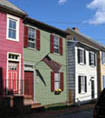 On our 10-day drive through Maryland and Virginia, my
husband and I met three presidents, saw three bears, and
discovered the delights of parkways and fancy dress. On our 10-day drive through Maryland and Virginia, my
husband and I met three presidents, saw three bears, and
discovered the delights of parkways and fancy dress.
Our horseshoe circuit began in Annapolis. Named after Que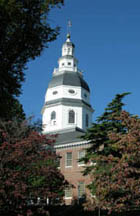 en
Anne, the city is 300 years old this year. It is quaintly
pretty, with uneven brick sidewalks and olde-worlde shops.
Our guide wore 18th-century costume, and, admonishing us for
stepping forth without bonnet or breeches, she escorted us
along cobbled streets of Georgian mansions and shingled
cottages. en
Anne, the city is 300 years old this year. It is quaintly
pretty, with uneven brick sidewalks and olde-worlde shops.
Our guide wore 18th-century costume, and, admonishing us for
stepping forth without bonnet or breeches, she escorted us
along cobbled streets of Georgian mansions and shingled
cottages.
The Annapolis state building is the oldest in continuous use
in America, and its wooden cupola, erected without nails,
was for years the country’s tallest building. The famous
naval academy boasts five miles of corridors and some of the
world’s largest dormitories. We watched the academy’s 4000
midshipmen (some of them women) on parade, white caps
bobbing above blue-black uniforms, accompanied by rousing
naval music. Beyond, Chesapeake Bay glittered in the
sunlight.
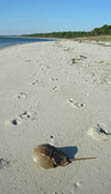 Between lunch (Maryland crab) and dinner (seared scallops
wrapped in applewood bacon) we sailed across the bay in a
schooner, propelled by warm winds. Our diminutive female
skipper navigated between crab-pots and naval ships, and my
husband and I took turns to pull sheets and take the tiller
as the boat listed alarmingly. Between lunch (Maryland crab) and dinner (seared scallops
wrapped in applewood bacon) we sailed across the bay in a
schooner, propelled by warm winds. Our diminutive female
skipper navigated between crab-pots and naval ships, and my
husband and I took turns to pull sheets and take the tiller
as the boat listed alarmingly.
Next day, we drove across the Bay Bridge and down the
Eastern Shore, on byways which wound through forests, cotton
fields, vineyards, trailer parks and shopping malls, with
glimpses of dazzling estuary. Maryland place-names have a
familiar ring – Oxford, Cambridge, Salisbury, Dorchester,
Somerset, Worcester. Stopping for petrol at Princess Anne,
we found to wnspeople in 18th-century dress, and historic
houses open. President James Madison, 5 foot 4 from buckled
shoe to powdered wig, greeted us in archaic speech. On
learning that my husband is called Guillaume, he enquired
whether I had perchance been abducted during the recent
seven-year war. wnspeople in 18th-century dress, and historic
houses open. President James Madison, 5 foot 4 from buckled
shoe to powdered wig, greeted us in archaic speech. On
learning that my husband is called Guillaume, he enquired
whether I had perchance been abducted during the recent
seven-year war.
We wanted to linger but we had far to go, into Virginia and
down a spit of land between bay and ocean. The verges were
dotted with road-kill – racoons and skunks. Overhead, black
vultures wheeled; an eagle perched on a fence as a flock of
geese flapped by. On a beach of fine sand, we found
sharp-tailed shells of king crabs, a creature 300 million
years old. Out in the bay, dolphins formed jet black arcs
against the silvery water.
Crossing the remarkable Chesapeake tunnel-bridge, we headed
for Jamestown, which in 1607 became America’s first
permanent English settlement. Virginians are proud that the
Ja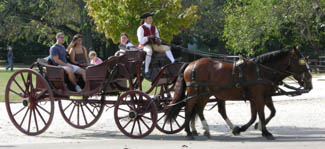 mestown charter introduced representative government, rule
of law, free enterprise, and English as a common language -
first in the colony, and eventually throughout the Union.
Jamestown today has reconstructed Indian huts, a triangular
wattle-and-daub fort and three sailing ships, where friendly
interpreters in period costume explained to us the customs
of Pocahontas’s Powhatan tribe, mestown charter introduced representative government, rule
of law, free enterprise, and English as a common language -
first in the colony, and eventually throughout the Union.
Jamestown today has reconstructed Indian huts, a triangular
wattle-and-daub fort and three sailing ships, where friendly
interpreters in period costume explained to us the customs
of Pocahontas’s Powhatan tribe, demonstrated sailors’ knots,
and fired matchlock muskets. demonstrated sailors’ knots,
and fired matchlock muskets.
Nearby
Colonial Williamsburg dispelled all remaining prejudices
against replica buildings and fancy dress. I had expected to
scoff, but I was captivated. We toured the governor’s
palace, witnessed criminal trials, listened to a sermon on
liberty, watched blacksmiths, armourers and saddlers at
work, and took a carriage ride along wide dirt roads. We
also met two more presidents. George Washington, six foot
two, with potato nose and sloping shoulders, held forth
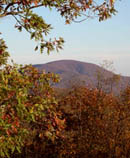 on
the iniquity of the English tax on tea. Thomas Jefferson, as
tall and more handsome, outlined his ideas for a declaration
of independence from the Crown. You would need a week to
appreciate Williamsburg properly. on
the iniquity of the English tax on tea. Thomas Jefferson, as
tall and more handsome, outlined his ideas for a declaration
of independence from the Crown. You would need a week to
appreciate Williamsburg properly.
Now we discovered the joy of parkways – all-American roads
built for gentle, stress-free motoring, with no traffic
lights, billboards, lorries or shops. The beautiful, empty
Colonial Parkway follows the wooded bank of the James River
to Yorktown, where the Victory Centre celebrates the
decisive battle of the American Revolution and the end of
169 years of English rule. Pictures of a s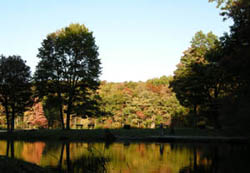 tatesmanlike
George Washington and a pompous, ermine-clad George III are
captioned with the loaded question, “Which would YOU
prefer?” tatesmanlike
George Washington and a pompous, ermine-clad George III are
captioned with the loaded question, “Which would YOU
prefer?”
Next day, we drove west through straggly towns, past farms
with white picket fences, woods and fields. We stopped at
ramshackle gas-stations where pickup-truck drivers tucked
into burgers and fries. In the late afternoon, blue-grey
mountains loomed on the horizon. The Blue Ridge Parkway is
America’s oldest and longest leisure drive. Created during
the depression of the 1930s, it follows the A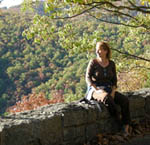 ppalachian
mountain range for 469 miles, linking the national parks of
the Great Smoky Mountains in the south and Shenandoah in the
north. ppalachian
mountain range for 469 miles, linking the national parks of
the Great Smoky Mountains in the south and Shenandoah in the
north.
The views from the ridge are legendary, but, alas, we awoke
to fog, driving rain and zero visibility. At overlooks, we
could only peer into nothingness, and imagine 60-mile
vistas. After cracking jokes about overlooking the
overlooks, we focussed on smaller pleasures, such as our
excellent eight-speed windscreen wipers. We tuned our radio
to wonderful bluegrass and country music, and then to Bible
readings, gospel singing, phone-ins, and weather forecasts
predicting more rain.

With anorak hoods up, we squelched on patchwork quilts of
fallen leaves beneath trees identified by sodden signs –
serviceberry, sourwood, sassasfras, sumac, hemlock, blackgum,
dogwood and tuliptree. Startled chipmunks, woodchucks,
skunks and squirrels scampered across parkway puddles.
White-tailed deer eyed us warily, and wild turkeys with lean
black bodies strutted into the dripping undergrowth. One
morning, by a creek swollen to a thundering brown torrent, a
black bear and two cubs ambled out of the trees. Before we
had time to be frightened, they had vanished into the mist.
 At Mabry Mill, we tucked into buckwheat pancakes and country
ham, as rain peppered the millpond and flooded the moonshine
stills, furnace and worm-pipes. Gracious Virginians, hearing
English accents, thanked us for bringing longed-for rain
from our famously foggy homeland. At Mabry Mill, we tucked into buckwheat pancakes and country
ham, as rain peppered the millpond and flooded the moonshine
stills, furnace and worm-pipes. Gracious Virginians, hearing
English accents, thanked us for bringing longed-for rain
from our famously foggy homeland.
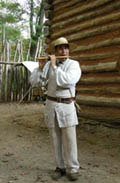 Roanoke’s Explore Centre was open despite the rain.
Following a woodland trail through a reconstructed Indian
village of bark hovels, we reached a stockaded homestead,
where a man in breeches and neckerchief was working a lathe.
He introduced himself as Vause, an 18th-century Scotch-Irish
settler. We followed him into his smoke-blackened log cabin,
where, with fire stoked and tallow candles flickering, he
drew us back to the days when Roanoke marked the frontier of
the Old Dominion. Beyond, enemy land of New France stretched
to Louisiana and Canada. In 1756, Vause’s farm was raided by
French and Indian marauders. All the men were killed, and
the women and children captured. As rain pelted down, our
most charismatic historian brought out a fife and played
Rule Britannia and The British Grenadier. Roanoke’s Explore Centre was open despite the rain.
Following a woodland trail through a reconstructed Indian
village of bark hovels, we reached a stockaded homestead,
where a man in breeches and neckerchief was working a lathe.
He introduced himself as Vause, an 18th-century Scotch-Irish
settler. We followed him into his smoke-blackened log cabin,
where, with fire stoked and tallow candles flickering, he
drew us back to the days when Roanoke marked the frontier of
the Old Dominion. Beyond, enemy land of New France stretched
to Louisiana and Canada. In 1756, Vause’s farm was raided by
French and Indian marauders. All the men were killed, and
the women and children captured. As rain pelted down, our
most charismatic historian brought out a fife and played
Rule Britannia and The British Grenadier.
Reluctantly leaving Vause to his lathe, we walked on to a
reconstructed hamlet of 19th-century cottages, barn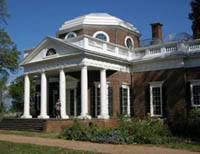 s,
watermill and school, where costumed villagers knitted,
baked, whittled and milled. A batteauman welcomed us into
his shack. Batteaumen were trusted slaves who steered
70-foot riverboats through treacherous rapids, carrying iron
ore, wood, furs and passengers on three-week journeys to
market. Despite Jefferson’s declarations of equality,
Virginians owned more slaves than any other colony. s,
watermill and school, where costumed villagers knitted,
baked, whittled and milled. A batteauman welcomed us into
his shack. Batteaumen were trusted slaves who steered
70-foot riverboats through treacherous rapids, carrying iron
ore, wood, furs and passengers on three-week journeys to
market. Despite Jefferson’s declarations of equality,
Virginians owned more slaves than any other colony.
One day, we took a detour from the Parkway to visit
Monticello, President Jefferson’s house, which he designed
himself and filled with his ingenious inventions. By now we
felt we knew America’s third president well. His familiar
face looked out of portraits, as did the instantly
recognisable face of his friend (and ours) James Madison,
who often stayed at Monticello.
 At last, after four days of rain, the skies brightened.
Ecstatic, we parked at every overlook to drink in majestic
views. We hiked along Skyline trails, clambered up knolls,
and sat gazing at misty ridges, stretching to infinity. Our
last dose of living history came at Middletown’s Wayside
Inn. Established in 1797, America’s longest running hotel
has beamed ceilings, lop-sided floors, waitresses in long
skirts, aprons and mob caps - and walls lined with portraits
of our friends, Washington, Jefferson and Madison. At last, after four days of rain, the skies brightened.
Ecstatic, we parked at every overlook to drink in majestic
views. We hiked along Skyline trails, clambered up knolls,
and sat gazing at misty ridges, stretching to infinity. Our
last dose of living history came at Middletown’s Wayside
Inn. Established in 1797, America’s longest running hotel
has beamed ceilings, lop-sided floors, waitresses in long
skirts, aprons and mob caps - and walls lined with portraits
of our friends, Washington, Jefferson and Madison.
North American Highways
www.nahighways.co.uk
First published by the Telegraph
©SarahShuckburgh |